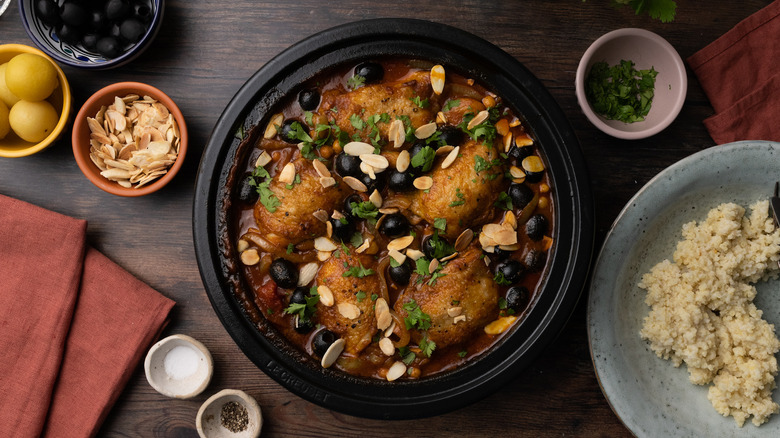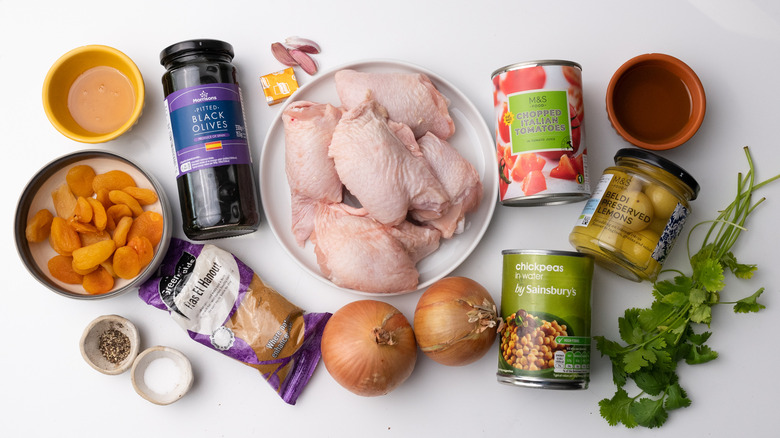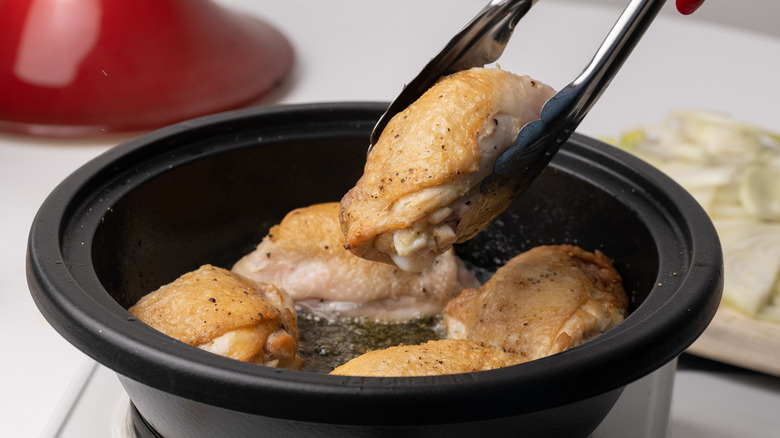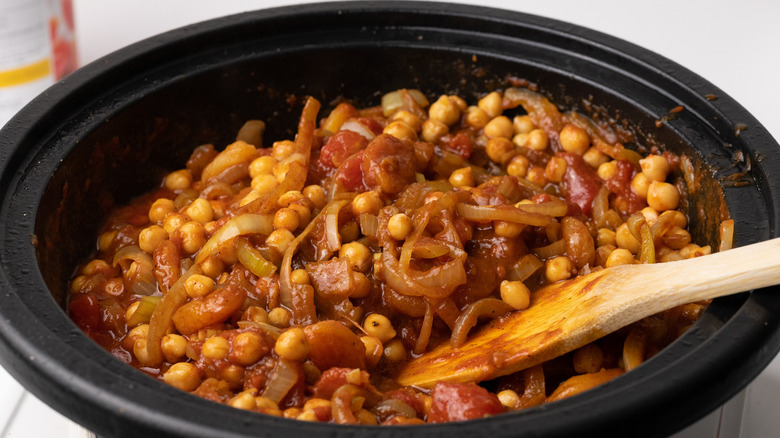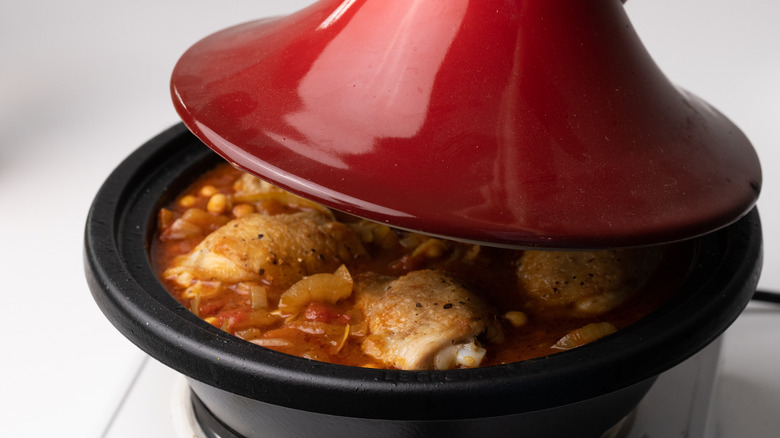Fragrant Moroccan-Style Chicken Tagine Recipe
If you've ever had the pleasure of eating a tagine before, you'll know that they are traditionally cooked and served in beautiful, and sometimes ornately decorated, cookware of the same name. Tagines are a type of Moroccan stew that is normally made using meat or fish, which is cooked along with vegetables and fruits in a delicious stew. The cookware they are prepared in, tagines, are most often made of clay and consist of a deep pot with a conical, chimney-shaped lid, which helps to circulate the steam creating deliciously moist, tender food.
However, if you don't happen to have this particular type of cookware knocking around in the back of your kitchen cupboard, don't worry. You can still make this fragrant Moroccan-style chicken tagine without a traditional tagine pot. Instead, you can use a hob-friendly casserole dish, crock pot, or heavy skillet with a lid. This chicken tagine dish, created by recipe developer Jennine Rye, is made using succulent chicken thighs cooked with onions, chickpeas, dried apricots, and black olives in a deliciously spiced and tangy tomato stew.
Gather the ingredients for this fragrant Moroccan-style chicken tagine
To make this fragrant Moroccan-style chicken tagine, first you will want to gather the ingredients. You will need chicken thighs, onions, garlic, ras el hanout, chickpeas, canned chopped tomatoes, dried apricots, honey, preserved lemons, chicken stock, black olives, and fresh coriander. As well as this, you will need the kitchen staples: cooking oil, and salt and pepper for seasoning.
This recipe uses preserved lemons which add a wonderful briny, astringent kick to your dish. They are often used in North African cooking and are an important element in this chicken tagine. However, if you can't find any in your local stores, it is possible to substitute this ingredient for fresh lemons, or you could always try making your own preserved lemons at home!
Brown the chicken
To start your chicken tagine, you will want to brown the chicken. This will give the chicken skin a beautiful color as well as releasing lots of delicious and rich flavors which will enhance the final dish. To do this, heat up the cooking oil in your tagine or chosen cookware, liberally season the chicken thighs with salt and pepper, and then place them skin side down in the hot oil. Allow the chicken to cook in the oil until it has reached a lovely golden color. Turn the thighs over and cook them for a few minutes more on the other side, and then remove the chicken from the pan and set it to one side.
Start the tagine
Once the chicken thighs have been removed from the pan, add the sliced onions and cook them in the residual oil. The pan should now be filled with delicious juices from the chicken which will be infused throughout the dish. Cook the onion until it is softened and translucent, and then add the chopped garlic and the ras el hanout: an aromatic spice mix often found in Moroccan cuisine. Allow the spice blend to cook for a minute or two until it is beautifully fragrant, and then add the chickpeas, the canned tomatoes, the dried apricots, the honey, the preserved lemon, and the chicken stock.
Finish the tagine
Add the golden chicken back into the tagine, nestling it into the tomato stew. Then, place the lid onto the tagine, or your chosen cookware, and allow everything to gently simmer for 30 minutes. At this point, add the olives to the tagine and allow everything to cook together for 10 more minutes. Your tagine is now ready to serve, sprinkled with fresh chopped coriander, and flaked almonds if you want an additional garnish option.
This fragrant Moroccan-style chicken tagine is best served alongside couscous, millet, or rice, to absorb all of the delicious juices from the stew. Any leftovers can be stored in the fridge in an airtight container for up to three days.
Fragrant Moroccan-Style Chicken Tagine Recipe
Learn how to make this Moroccan-style dish that takes less than an hour and will fill your kitchen with delicious cooking and seasoning smells.
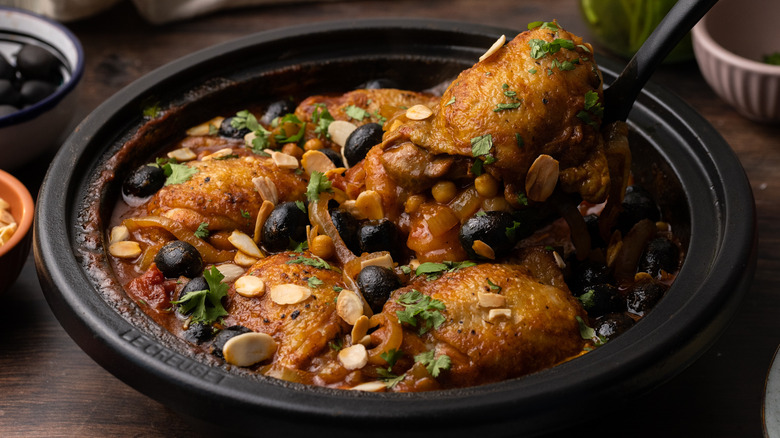
Ingredients
- ¼ cup cooking oil
- 1 ½ lb chicken thighs, bone-in and skin on
- Salt and pepper, to taste
- 2 large onions
- 3 cloves garlic, chopped
- 2 tablespoons ras el hanout
- 1 can chickpeas, drained
- 1 can chopped tomatoes
- ¾ cup dried apricots
- 2 tablespoons honey
- 2 preserved lemons, finely chopped
- 1 cup chicken stock
- 3.5oz black olives
- 2 tablespoons chopped fresh coriander, to garnish
Optional Ingredients
- 2 tablespoons flaked almonds, to garnish
Directions
- Heat the cooking oil to a medium high heat in a tagine or cooking pot with a lid. Season the chicken thighs, and then place them into the pan to fry for 5 minutes until they are golden in color.
- Remove the chicken from the pan. Slice the onions into strips, and then add them to the pan and fry them for 5 minutes until they are softened and translucent.
- Add the garlic and the ras el hanout, and cook everything together for another 2 to 3 minutes until fragrant.
- Add the drained chickpeas, the chopped tomatoes, the dried apricots, the honey, the finely chopped preserved lemon, and the chicken stock to the pan. Mix everything together and then return the chicken to the pan. Place the tagine lid onto the pot and let the tagine cook for 30 minutes.
- Add the olives to the pan and cook the tagine for 10 more minutes, until the chicken is cooked through and tender.
- Serve the tagine with the chicken thighs whole, or you can shred the chicken and mix it into the rest of the tagine. Sprinkle with fresh coriander and sliced almonds if desired.
Nutrition
| Calories per Serving | 853 |
| Total Fat | 49.2 g |
| Saturated Fat | 9.8 g |
| Trans Fat | 0.2 g |
| Cholesterol | 168.5 mg |
| Total Carbohydrates | 68.1 g |
| Dietary Fiber | 14.5 g |
| Total Sugars | 32.4 g |
| Sodium | 1,353.1 mg |
| Protein | 40.6 g |

